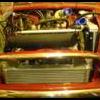
Spot Welder Question
#1

Posted 06 November 2014 - 07:33 PM
I'm considering getting a spot welder but looking at those available they state they can't be run from a standard 13a mains plug / supply. Stating they require a fused 16A or 25A isolated supply.
I appreciate it's is probably a question for an electrician but how do people normally power these In a domestic situation? I've got a standard spur from the house to the garage.
I've seen pictures on eBay etc showing welder with 13a plugs attached, so I'm a bit confused
Thanks for you help
Chris
#2

Posted 06 November 2014 - 07:38 PM
#3

Posted 06 November 2014 - 07:51 PM
#4

Posted 06 November 2014 - 08:13 PM
#5

Posted 06 November 2014 - 08:26 PM
My garage is about 50 feet from the house and I run my spot welder from a 13A plug.
I have a supply running from the main fuse board in the house and a separate trip in the garage.
#7

Posted 07 November 2014 - 09:14 AM
i agree about it being potentially dangerous, but is it not 16A maximum draw? I have a clarke 151 mig wlder that required a 16A socket (the 3 pin type socket). I run it on a standard 13A socket, as i have never goin above 30% power (and to be fair most likely will never go beyond that). This is what i do, and its not a recommendation. Best to play it safe!
Edited by finch661, 07 November 2014 - 11:05 AM.
#8

Posted 07 November 2014 - 10:47 AM
Not dangerous at all so long as you don't start sticking 16A fuses on the end of a wire that's only rated at 13A.
Assuming the spot welder will draw less than 13A for the thickness of steel that you are welding then just stick a 13A plug on it and use it. If you do turn it up and the welder tries to draw more current then the fuse will blow - the fuse is there to protect the wiring, not the device on the end of it.
I have a 150Amp mig and a 200Amp TIG. Both are supposed to have bigger than a 13A supply and the round plug but I run them on standard 13A plugs. I've never done it with the TIG but if I turn the MIG right up and run a long-ish continuous weld then it'll blow the fuse in the plug. The only thing to be aware of is that a fuse will take some seconds of it's maximum rating to blow so the wiring may be called on to draw 13A or slightly more for a few seconds. The more current you try to draw then the faster the fuse will blow so if the welder does try to pull 16A then the fuse will pop almost instantaneously. It's for this reason that the wiring for a 13A socket "should" be rated at a good chunk more than 13A if it's been installed according to the regs and that goes for the cable out to your garage - if it's been installed by some cowboy who used lower rated cable then all bets are off.
Iain
#9

Posted 07 November 2014 - 11:45 AM
Edited by megamini_jb, 07 November 2014 - 11:59 AM.
#10

Posted 07 November 2014 - 11:57 AM
for my tig I have a long heavy duty extention lead with a 30A socket on the end that I run from the cooker socket in the kitchen, these are a 13A socket, but they are a bit more sturdy in the wiring dept, just keep the duty cycle down a bit.
#11

Posted 07 November 2014 - 08:08 PM
the problem is that you are assuming everything is in perfect condition and that wiring has been done to a decent standard. What usually happens is people just stick a 13a plug on the end and don't check anything else, therefore suggesting that it is isn't dangerous is dangerous advice. It's no good saying all bets are off at the end having said it isn't dangerous earlier on. Without knowing an individual installation your advice could lead to overloading and potentially a fire. They are rated at 16A for a reason, if they didn't need to be they wouldn't be.Not dangerous at all so long as you don't start sticking 16A fuses on the end of a wire that's only rated at 13A.
Assuming the spot welder will draw less than 13A for the thickness of steel that you are welding then just stick a 13A plug on it and use it. If you do turn it up and the welder tries to draw more current then the fuse will blow - the fuse is there to protect the wiring, not the device on the end of it.
I have a 150Amp mig and a 200Amp TIG. Both are supposed to have bigger than a 13A supply and the round plug but I run them on standard 13A plugs. I've never done it with the TIG but if I turn the MIG right up and run a long-ish continuous weld then it'll blow the fuse in the plug. The only thing to be aware of is that a fuse will take some seconds of it's maximum rating to blow so the wiring may be called on to draw 13A or slightly more for a few seconds. The more current you try to draw then the faster the fuse will blow so if the welder does try to pull 16A then the fuse will pop almost instantaneously. It's for this reason that the wiring for a 13A socket "should" be rated at a good chunk more than 13A if it's been installed according to the regs and that goes for the cable out to your garage - if it's been installed by some cowboy who used lower rated cable then all bets are off.
Iain
#12

Posted 07 November 2014 - 09:36 PM
A cooker switch does have a higher rating but the socket outlet part of it is still only designed to take 13A.
If you have any doubt that your current garage supply is not up to the job i would get a local electrician to check it and advise any upgrades you might need.
As a general rule i would wire a 16A or 20A supply to an isolator or commando socket in 2.5mm cable and a 32A supply in 4mm cable and use the correct mcb in the consumer unit. But this could change from installation to installation.
#13

Posted 11 November 2014 - 03:38 PM
the problem is that you are assuming everything is in perfect condition and that wiring has been done to a decent standard. What usually happens is people just stick a 13a plug on the end and don't check anything else, therefore suggesting that it is isn't dangerous is dangerous advice. It's no good saying all bets are off at the end having said it isn't dangerous earlier on. Without knowing an individual installation your advice could lead to overloading and potentially a fire. They are rated at 16A for a reason, if they didn't need to be they wouldn't be.Not dangerous at all so long as you don't start sticking 16A fuses on the end of a wire that's only rated at 13A.
Assuming the spot welder will draw less than 13A for the thickness of steel that you are welding then just stick a 13A plug on it and use it. If you do turn it up and the welder tries to draw more current then the fuse will blow - the fuse is there to protect the wiring, not the device on the end of it.
I have a 150Amp mig and a 200Amp TIG. Both are supposed to have bigger than a 13A supply and the round plug but I run them on standard 13A plugs. I've never done it with the TIG but if I turn the MIG right up and run a long-ish continuous weld then it'll blow the fuse in the plug. The only thing to be aware of is that a fuse will take some seconds of it's maximum rating to blow so the wiring may be called on to draw 13A or slightly more for a few seconds. The more current you try to draw then the faster the fuse will blow so if the welder does try to pull 16A then the fuse will pop almost instantaneously. It's for this reason that the wiring for a 13A socket "should" be rated at a good chunk more than 13A if it's been installed according to the regs and that goes for the cable out to your garage - if it's been installed by some cowboy who used lower rated cable then all bets are off.
Iain
But if the wiring is dodgy to start with then plugging in a 90Amp MIG welder that's only designed to use a 13Amp plug is still going to be just as dangerous.
They are rated at 16Amp because that's slightly more than the maximum that it will draw in normal operation when turned up to the maximum. That doesn't mean it will ever draw anywhere near that in real world use - just that it might.
If there are 13Amp sockets there in the workspace then we can only assume that they are safe to be used as designed (which is to run multiple devices fused at 13A with a safety margin). With that assumption then running a higher rated device from them is perfectly safe so long as it's still fused at 13A. That's what my FIRST sentence says.
OK if my assumption is wrong then the OP might manage to burn his house down but if the wiring is that bad then there's just as much chance of him doing that with any other device fused at 13A as with a welder fused at 13A.
Iain
#14

Posted 11 November 2014 - 04:08 PM
There is one for sale on the forum, well there was.
#15

Posted 11 November 2014 - 05:49 PM
I am surprised you can't see the fault with your logic. You assume the spot welder WONT draw 16A and assume a mig welder WILL draw 13A and therefore the current draw is similar??????? The reality is that the spot welder AND the mig welder will draw below the max rated current, but as that is 13A for the mig, the chances are it will draw less than the spot welder. As the heat in a resistor (the wire) is due to current flow, adding to that the fact that a resistor increases in resistance as it gets hot, then using a spot welder on a 13A circuit WILL increase the risk of problems. Possibly dangerously so.the problem is that you are assuming everything is in perfect condition and that wiring has been done to a decent standard. What usually happens is people just stick a 13a plug on the end and don't check anything else, therefore suggesting that it is isn't dangerous is dangerous advice. It's no good saying all bets are off at the end having said it isn't dangerous earlier on. Without knowing an individual installation your advice could lead to overloading and potentially a fire. They are rated at 16A for a reason, if they didn't need to be they wouldn't be.Not dangerous at all so long as you don't start sticking 16A fuses on the end of a wire that's only rated at 13A.
Assuming the spot welder will draw less than 13A for the thickness of steel that you are welding then just stick a 13A plug on it and use it. If you do turn it up and the welder tries to draw more current then the fuse will blow - the fuse is there to protect the wiring, not the device on the end of it.
I have a 150Amp mig and a 200Amp TIG. Both are supposed to have bigger than a 13A supply and the round plug but I run them on standard 13A plugs. I've never done it with the TIG but if I turn the MIG right up and run a long-ish continuous weld then it'll blow the fuse in the plug. The only thing to be aware of is that a fuse will take some seconds of it's maximum rating to blow so the wiring may be called on to draw 13A or slightly more for a few seconds. The more current you try to draw then the faster the fuse will blow so if the welder does try to pull 16A then the fuse will pop almost instantaneously. It's for this reason that the wiring for a 13A socket "should" be rated at a good chunk more than 13A if it's been installed according to the regs and that goes for the cable out to your garage - if it's been installed by some cowboy who used lower rated cable then all bets are off.
Iain
But if the wiring is dodgy to start with then plugging in a 90Amp MIG welder that's only designed to use a 13Amp plug is still going to be just as dangerous.
They are rated at 16Amp because that's slightly more than the maximum that it will draw in normal operation when turned up to the maximum. That doesn't mean it will ever draw anywhere near that in real world use - just that it might.
If there are 13Amp sockets there in the workspace then we can only assume that they are safe to be used as designed (which is to run multiple devices fused at 13A with a safety margin). With that assumption then running a higher rated device from them is perfectly safe so long as it's still fused at 13A. That's what my FIRST sentence says.
OK if my assumption is wrong then the OP might manage to burn his house down but if the wiring is that bad then there's just as much chance of him doing that with any other device fused at 13A as with a welder fused at 13A.
Iain
If they didn't need to be 16A rated they wouldn't be. These things aren't done for fun.
1 user(s) are reading this topic
0 members, 1 guests, 0 anonymous users




















